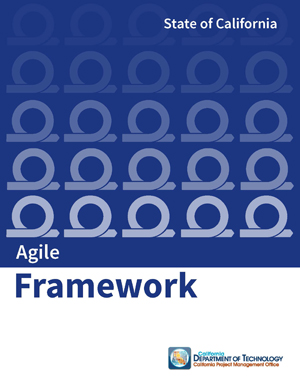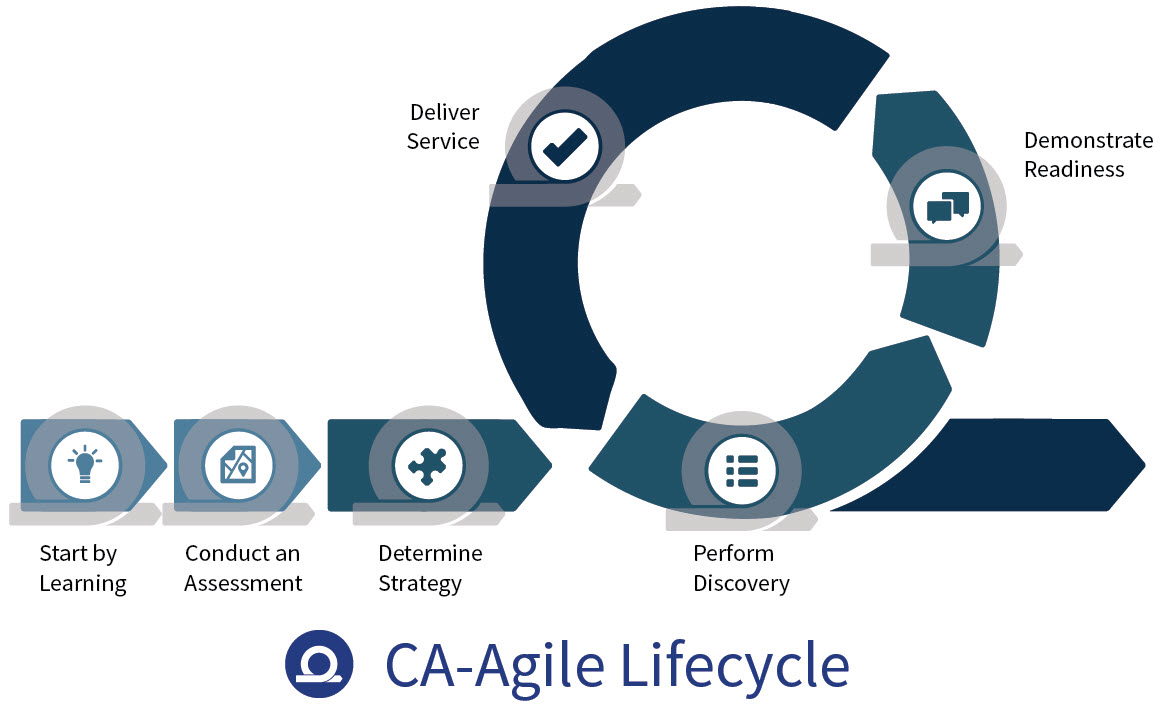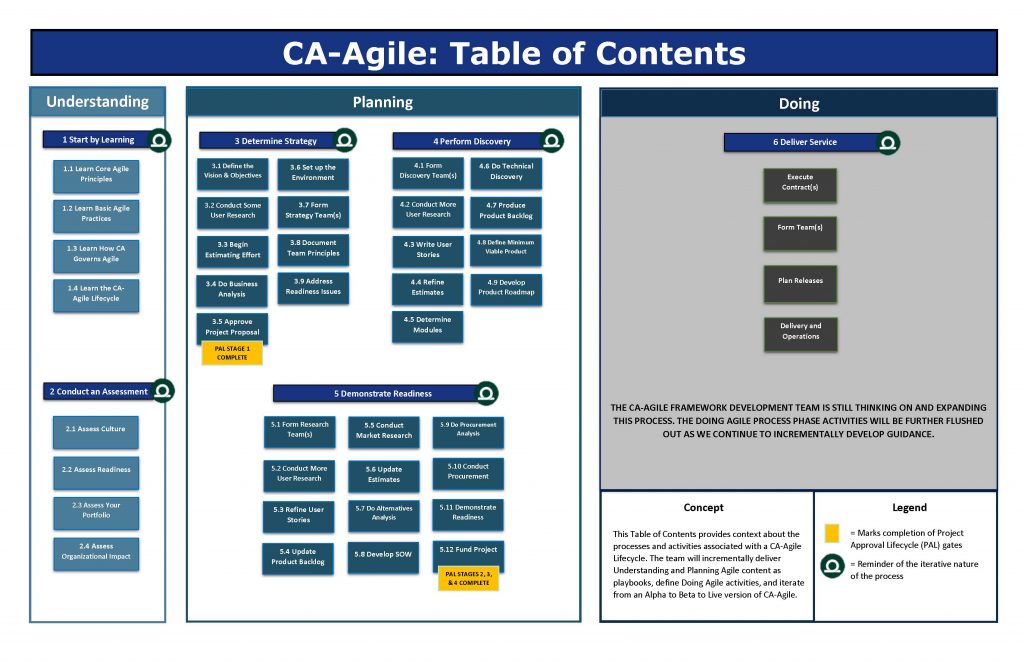
California Agile Framework (CA-Agile)
The California Project Management Office (CA-PMO) developed the California Agile Framework (CA-Agile) to provide project practitioners with practical guidance for managing iterative incremental project delivery activities. The CA-Agile provides guidance on agile methods and approaches through the use of resources, and tools, as well as narrative describing when and how specific project activities may be performed throughout an agile project management lifecycle.
The CA-Agile is designed to help organizations manage agile delivery in order to achieve the business outcomes associated with these efforts. While the CA-Agile is written in the context of information technology (IT) implementation efforts, it is applicable to any type of project where an alternative approach to the waterfall method is desired.
Explore CA-Agile
Click on a panel to expand the view and see the additional content.
Overview
Lifecycle
The CA-Agile lifecycle groups activities into three distinct CA-Agile Process Phases: Understanding, Planning, and Doing. The CA-Agile lifecycle, Figure 1-1 shows the iterative nature of each process.
- Understanding
- Start by Learning
- Conduct an Assessment
- Planning
- Determine Strategy
- Perform Discovery
- Demonstrate Readiness
- Doing
- Deliver Service
Table of Contents
Within each CA-Agile process, there are topics or activities that reflect what CDT recommends agile teams do to complete the work associated with a process. Figure 1-2, the CA-Agile Table of Contents is the collection of all three layers of this information on one page— the Process Phases, the processes, and the activities.
Understanding Agile PDF
The “Understanding Agile” document was the first increment released in the CA-Agile Framework. This content has been incorporated into CA-Agile playbooks within the “Understanding” Process Phase. Alternatively, it can be downloaded in its original form at: Understanding Agile.
Understanding
Understanding is the first Process Phase in the CA-Agile lifecycle. Starting here will help to ensure a common understanding of what agile is, and prime organizations for more in-depth conversations about adopting and using agile planning and doing methodologies. Content that is available for exploration is shown with a blue link to the playbook. Additional content will be added incrementally.
1 Start by Learning
- 1.1 Learn Core Agile Principles
- 1.2 Learn Basic Agile Practices
- 1.3 Learn how California Governs Agile
- 1.4 Learn the CA-Agile Lifecycle
2 Conduct an Assessment
- 2.1 Assess Culture
- 2.2 Assess Readiness
- 2.3 Assess Your Portfolio
- 2.4 Assess Organizational Impact
Planning
Planning is the second Process Phase in the CA-Agile lifecycle. Your work here will help to ensure thoughtful planning for your agile project and prepare your organization for the next process phase of doing agile delivery. Content that is available for exploration is shown with a blue link to the playbook. Additional content will be added incrementally.
3 Determine Strategy
- 3.1 Define the Vision and Objectives
- 3.2 Conduct Some User Research
- 3.3 Begin Estimating Effort
- 3.4 Do Business Analysis
- 3.5 Approve Project Proposal
- 3.6 Set up the Environment
- 3.7 Form Strategy Team(s)
- 3.8 Document Team Principles
- 3.9 Address Readiness Issues
4 Perform Discovery
- 4.1 Form the Discovery Team(s)
- 4.2 Conduct More User Research
- 4.3 Write User Stories
- 4.4 Refine Estimates
- 4.5 Determine Modules
- 4.6 Do Technical Discovery
- 4.7 Produce Product Backlog
- 4.8 Define Minimum Viable Product (MVP)
- 4.9 Develop Product Roadmap
5 Demonstrate Readiness
- 5.1 Form Research Team(s)
- 5.2 Conduct More User Research
- 5.3 Refine User Stories
- 5.4 Update Product Backlog
- 5.5 Conduct Market Research
- 5.6 Update Estimates
- 5.7 Do Alternatives Analysis
- 5.8 Develop Statement of Work (SOW)
- 5.9 Do Procurement Analysis
- 5.10 Conduct Procurement
- 5.11 Demonstrate Readiness
- 5.12 Fund Project
Doing
Doing is the third and final Process Phase in the CA-Agile lifecycle. Your work here will help the team deliver your agile project in a way that meets the needs of your users. At the end of this process phase, the project team will have transitioned the project deliverables to Live. The structure and content of this Process Phase is still being further developed and thought through as CA-Agile is developed.
6 Deliver Service
- Execute Contract(s)
- Form Team(s)
- Plan Releases
- Delivery and Operations
FAQ
The following list of Frequently Asked Questions (FAQ) questions have been developed to help you navigate CA-Agile. If you have a question that is not addressed, feel free to contact us.
- What is CA-Agile and do I need it?
- What is the purpose of CA-Agile?
- Who is the audience of CA-Agile?
- How is CA-Agile being developed and what is the launch strategy?
- Are Agencies and state entities (including their vendors or contractors) required to use the CA-Agile even though they may have their own agile guidance or other tools?
- How does CA-Agile relate to the CA-PMF, the CA-OCM, and the CA-BPR frameworks?
- How does CA-Agile relate to the Project Approval Lifecycle (PAL)?
- I have a question that is not addressed regarding CA-Agile. Who can I contact?
1. What is CA-Agile and do I need it?
CA-Agile stands for California Agile and is a framework that encompasses the agile discipline for those who will undergo an iterative agile approach. Use this guidance to evaluate if your organization is ready to deliver projects in an agile way. If your organization or project chooses this approach, CA-Agile can be used to provide the necessary guidance.
2. What is the purpose of CA-Agile?
The purpose of CA-Agile is to assist organizations in understanding, planning, and doing agile. While CA-Agile is written in the context of information technology (IT) implementation efforts, it can be applicable to almost any type of project.
3. Who is the audience of CA-Agile??
The intended audience for CA-Agile includes practitioners who want to learn more about agile, those who will be undertaking an iterative agile approach, or even those who are looking for alternatives to traditional project management. CA-Agile seeks to provide helpful information for organizations to evaluate, prepare for, and conduct an agile effort.
4. How is CA-Agile being developed and what is the launch strategy?
CA-Agile is being developed and launched in an incremental and iterative manner by the California Project Management Office (CA-PMO) of the California Department of Technology (CDT) to provide practical guidance when undertaking an iterative agile approach. CA-Agile content is initially launched as an alpha. Updated beta versions of previously developed guidance will be launched iteratively.
5. Are Agencies and state entities (including their vendors or contractors) required to use CA-Agile even though they may have their own agile guidance or other tools?
The use of CA-Agile is not mandated, but it does provide a foundation of best practice guidance for state organizations to leverage when undergoing an iterative agile approach. This is unlike the CA-PMF where agencies and state entities must follow the CA-PMF unless they have an alternative PMBOK-based framework that is comparable, as stated in 4819.31 of SAM Section 4800.
6. How does CA-Agile relate to the CA-PMF, the CA-OCM, and the CA-BPR frameworks?
CA-Agile is geared towards those projects that will undergo an iterative agile approach. The CA-PMF is a framework that was developed to follow the traditional waterfall methodology. In certain areas of the CA-PMF information pertaining to user-centered concepts have been incorporated. The CA-OCM and CA-BPR are frameworks aligned to the CA-PMF, that can be utilized anytime an organization wants to address organizational change or conduct business process reengineering. Depending on the nature of your project you may leverage elements from more than one framework or toolset.
7. How does CA-Agile relate to the Project Approval Lifecycle (PAL)?
The PAL is the state’s process for approving IT projects. The PAL is intended to ensure projects are undertaken with clear business objectives, accurate costs, and realistic schedules. The current PAL adjusts on a case-by-case basis for projects proposing an agile planning and development approach. A more integrated PAL for Agile is under development, however, in both cases, CA-Agile content will provide guidance that can be leveraged when preparing your PAL materials in areas such as authorizing the project, doing the alternatives analysis, doing the procurement analysis, and more broadly demonstrating readiness to proceed to development.
8. I have a question that is not addressed regarding the CA-Agile. Who can I contact?
Feel free to contact us.



